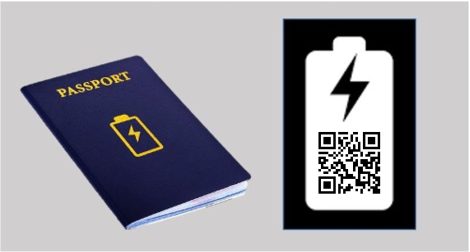Introduction
 A digital battery passport provides easy access to structured, reliable, and complete information about the battery. This fresh initiative in the U.S. lithium battery landscape aims to simplify the choice and use of batteries for consumers. The U.S. government agencies are working on battery passport requirements, centralizing battery specifications and pertinent details, making it user-friendly for the everyday buyer. This digital battery passport offers a streamlined gateway to trustworthy and comprehensive battery data. Its widespread embrace is important for battery industry growth, pioneering products, safety, and environmental stewardship. As U.S. government bodies shape this directive, those in the electric industrial equipment sector can reference the EU’s recent regulations for insight. But, what exactly is a digital battery passport?
A digital battery passport provides easy access to structured, reliable, and complete information about the battery. This fresh initiative in the U.S. lithium battery landscape aims to simplify the choice and use of batteries for consumers. The U.S. government agencies are working on battery passport requirements, centralizing battery specifications and pertinent details, making it user-friendly for the everyday buyer. This digital battery passport offers a streamlined gateway to trustworthy and comprehensive battery data. Its widespread embrace is important for battery industry growth, pioneering products, safety, and environmental stewardship. As U.S. government bodies shape this directive, those in the electric industrial equipment sector can reference the EU’s recent regulations for insight. But, what exactly is a digital battery passport?
Digital Battery Passport provides transparency, rewards responsibility
A digital battery passport is a unique file created for each battery that contains complete information about the battery, its components, technical specifications, telemetry data, service history, expected life, etc. It is provided by the manufacturer to authorized operators. For companies operating electric industrial equipment, easy access to complete battery data translates into higher efficiency in their fleet management and equipment utilization. It also makes corporate ESG and emissions reporting easier.
Supporting the development of a competitive, innovative battery market
Structured and complete information helps operators increase battery serviceability and take the guesswork out of decisions on whether a battery is compatible with particular equipment. The data about installed integration protocols provides easier market access for new battery products, and fosters competition and innovation. Access to BMS data and software can help update CAN integration protocols with a charger and host vehicle or repurpose a battery for a subsequent application.
Equipment utilization, reusing, and repurposing of lithium batteries
The current lack of transparency in any battery’s actual state of health (SOH), expected cycle life, maintenance, and service history is a barrier to improving equipment utilization. This data can also help to define battery compatibility with secondhand equipment or repurposing. Reliable and easily accessible battery data will reduce the cost of testing and evaluation and help recover the residual value of a used battery.
Ensuring a high level of environmental protection in the USA
Manufacturer and user ESG claims can be substantiated with verified information on battery key specifications, such as cell chemistry, the origin of the core battery materials, the share of recycled materials used in manufacturing, and the full cycle carbon footprint.
Supporting the growth of renewable energy sources, reducing CO2 emissions
Testing and evaluating cells in used Li-ion battery packs is a bottleneck in the emerging business of re-manufacturing EV batteries for solar energy storage applications. Accurate battery data helps solve the problem of battery evaluation, reducing the cost of repurposing batteries for solar energy storage, and supporting the growth of renewable solar-generated electricity. With fewer batteries to recycle, the energy usage for recycling and waste management is reduced, resulting in fewer CO2 emissions.
What are the main requirements of the recent EU “battery passport” regulations?
The new EU “digital battery passport” regulation came into effect on 08/17/2023, with a planned start date of 02/18/2024. It introduces a few major demands for the batteries sold in the EU and is a good precedent for the US business community to study and learn from. All battery packs having a capacity over 2 kWh will need to have a digital battery passport to carry a disclosure of the CO2 footprint over the battery’s full life cycle, and to allow for user access to data on the battery’s state of charge and the number of cycles left in the battery before end-of-use.
New rules have been introduced for repurposing and recycling, as well as a requirement for a minimum content of recycled metals used in manufacturing (cobalt, nickel, lithium, and lead).
We wrote about how the data capabilities of forklift lithium batteries in the US can provide a solution to help EV car buyers and sellers deal with the current obscurity of battery health. Digital battery passports are a big step forward in solving this issue.
Sustainability and Safety
All rechargeable industrial batteries with a capacity of more than 2 kWh must have a “clearly legible and indelible” carbon footprint declaration and a label indicating (amongst other information) the levels of recycled cobalt, lead, lithium, and nickel used in the production of that battery.
Digital battery passport
EV batteries and rechargeable industrial batteries with a capacity of more than 2 kWh will need a “digital battery passport,” with information on the battery model, the specific battery, and its use. More generally, all batteries must have labels and QR codes detailing their capacity, performance, durability, and chemical composition and show the “separate collection” symbol.
For batteries using a battery management system, the end-user should be able to determine the state of health and expected lifetime of such batteries at any time based on the data stored in the battery management system. This data should be updated at least daily, or more frequently where that is required for a specific purpose.
Recycling / End-of-Life Management
The battery management system of EV batteries shall include a software reset function, in case enterprises carrying out preparations for the re-use, repurposing, or re-manufacturing of EV batteries need to upload different battery management system software.
Benefits of a mandatory digital battery passport for US users and dealers of industrial equipment
A unique “digital passport” can reduce the complexity and minimize the risks of choosing, buying, and servicing an industrial battery for US customers. On the other hand, excessive regulation runs a risk of stymied product development and price increases. Some US battery manufacturers, like OneCharge, have already developed digital passports for their batteries giving users access to the battery data. What are the data points they can provide today?
Digital Battery Passport Datapoints
Each OneCharge battery is Wi-Fi-enabled and provides authorized users with complete, up-to-date battery data, including the following data points:
- battery model and serial number—these help consumers identify the battery and to find information about it online or in product manuals
- manufacturer’s name and contact details—these allow consumers to contact the manufacturer if they have any questions or problems with the battery
- battery capacity—measured in kilowatt-hours (kWh), this is the amount of energy that the battery can store
- limits on continued and maximum charging, over-charging, discharging, and over-discharging current—measured in amperes (Amps), these indicate how much current can be charged to or drawn from the battery
- nominal, maximum, and minimum voltage—measured in volts (V), this is the voltage range at which the battery is designed to operate
- state of health and expected cycle life of the battery—measured in number of cycles, this is the number of times that the battery can be fully charged and discharged before it starts to lose its capacity below the warrantied threshold
- chemical composition and cell origin
- compatibility and connection protocols—these are the installed protocols of CAN integration with the charger and the host vehicle.
- safety information—this information includes warnings about the hazards of using the battery and also includes instructions on safely using and shipping the battery.
How can electric forklift fleet operators benefit from digital battery passports?
Instant and easy access to complete information about a given battery provides multiple benefits to both operators and dealers of electric industrial equipment such as forklifts:
- It eliminates the risks associated with equipment compatibility and integration.
- It significantly reduces the risks of battery breakdown caused by operator abuse or negligence.
- It accurately predicts the battery’s applicability in different use scenarios and its residual value.
- It informs fleet managers of the battery’s carbon footprint, repurposing, and recycling options.
- It reduces the cost of repurposing each individual cell by bypassing the extensive testing stage of rebuilding used batteries for lower power-use applications, such as energy storage.
Summary
Digital battery passports are a promising new technology that can help the battery industry develop and become more sustainable. They are already applicable to forklift batteries and, more broadly, to industrial batteries.
Transparency: digital battery passports provide easy access to complete battery data, which can help improve battery serviceability, market access, and competition.
Responsible business: digital battery passports can track battery sustainability performance, which can encourage companies to use sustainable materials and recycling practices.
Environmental impact: digital battery passports can promote reuse and recycling, which can improve battery testing efficiency and supply chain transparency.
 by Maxim Khabur | November 2, 2023
by Maxim Khabur | November 2, 2023